Coastal artillery complex A-222 "Bereg" and its capabilities
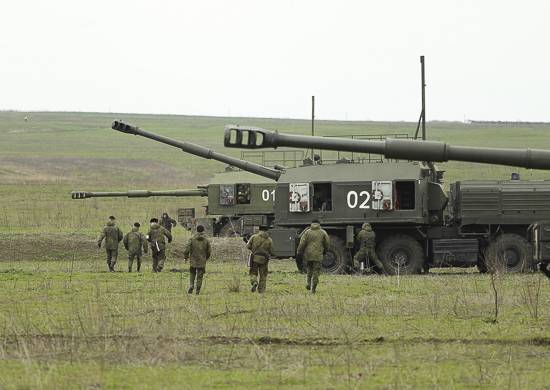
Means of the Bereg complex in position
The Russian Navy solves the problem of protecting the coast by various means. One of them is the A-222 Bereg self-propelled coastal artillery complex, capable of finding various surface targets and hitting them with precise fire. This complex was built using a number of interesting technical ideas, due to which it differs significantly from other artillery systems and effectively solves its problems.
Long way to the troops
In the mid-seventies, in the course of regular theoretical work, it was established that the coastal forces of the Navy required not only anti-ship missiles, but also artillery systems to effectively protect the coast. Guns with a firing range of no more than tens of kilometers were proposed to be used against targets near the coast or on land, and in addition, they were supposed to cover the dead zones of anti-ship missiles.
The development of such a coastal artillery complex (BAK) was launched in 1976. The creation of the project with the code "Coast" was entrusted to OKB-2 of the Volgograd enterprise "Barricades" (now NPC "Titan-Barricades") and several related enterprises, which were responsible for the creation and supply of individual components. Work started at the end of the year and continued for several years. In 1980, the design documentation was transferred to production.
Due to the overall complexity of the project, certain difficulties and a general negative background, the first experimental Bereg complex was built only in 1988. Soon it was sent to Crimea to undergo testing at the Black Sea testing grounds fleet. These activities continued until 1992, and the promising UAV confirmed all the calculated characteristics, and also demonstrated the ability to hit various targets in a given range.
The A-222 product was accepted into service with the coastal forces of the Navy only in 1996. The launch of serial production and supply of equipment to the troops also took time. The first production complex was transferred to the Black Sea Fleet only in 2003. Then deliveries continued, but in limited quantities.
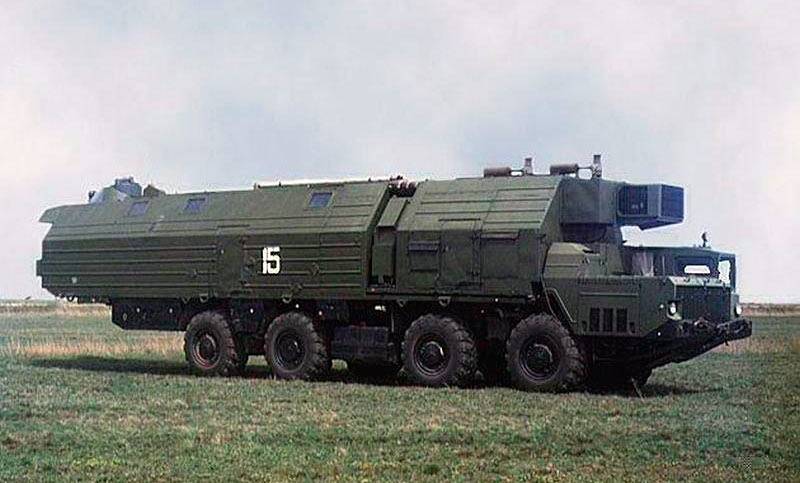
Self-propelled central post of the A-222 complex
According to various sources, no more than 5-6 complexes were built over the entire period; the total number of artillery systems in their composition is 36 units. Each complex is organizationally a division with three batteries of two self-propelled guns each. Due to the specifics of the tasks being solved, only the Black Sea Fleet has such divisions.
Technical features
The A-222 "Bereg" is a self-propelled artillery system with 130 mm caliber guns, capable of independently and without external assistance detecting and hitting various surface and ground targets. Combat work is ensured in prepared and unprepared positions, at any time of the day and in a wide range of weather conditions, as well as in the face of enemy opposition.
The Bereg BAK division includes a central post, six self-propelled artillery units and one or two combat duty support vehicles. All means of the complex are built on special wheeled chassis MAZ-543M, due to which high mobility and agility are achieved. In addition, wheeled chassis have operational advantages over tracked ones.
The central post of "Berega" is a self-propelled vehicle with a kung van, which houses the necessary equipment and work stations. The CPU crew includes 7 people. The curb weight is 43,7 tons, but the load-lifting chassis provides high mobility.
The CPU of the A-222 complex is equipped with its own radar and optical location station. They provide detection and tracking of surface objects of various sizes at a distance of at least 35 km. Two detection channels can operate in several modes, from manual to fully automatic. In this case, the coordinates of the target are calculated and data for firing is provided. Commands are transmitted to the self-propelled guns via radio channel.
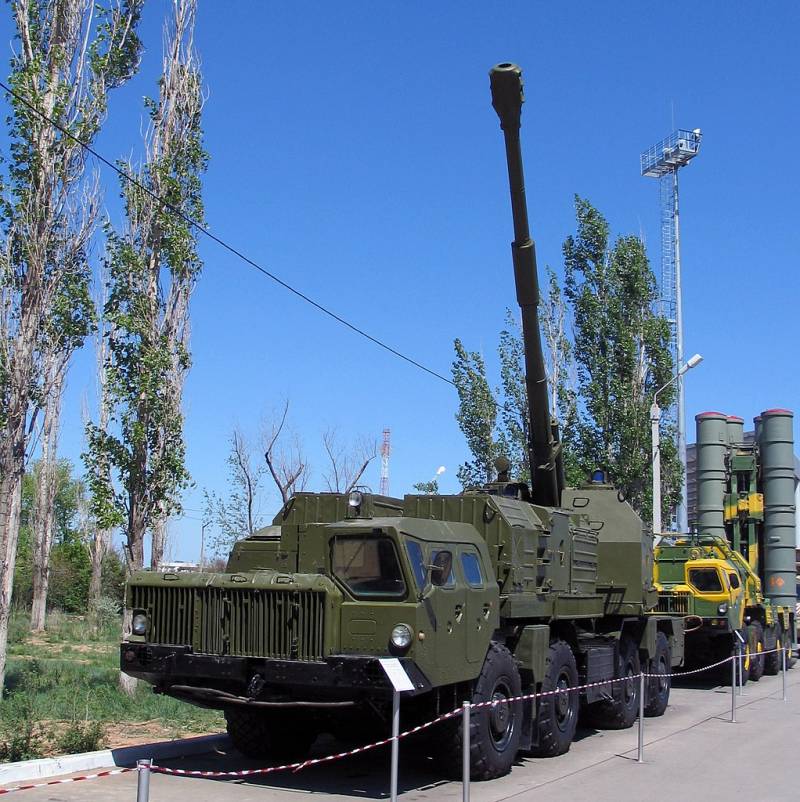
artillery mount
The self-propelled artillery mount for the Bereg received a fighting compartment in the form of a large rotating turret containing weapons, crew positions, etc. In the stowed position, the turret is turned with the gun forward, and the barrel is placed next to the chassis cabin. In the combat position, the self-propelled gun is placed with its stern in the direction of the target and turns the gun backwards. The tower can be rotated within 120° to the right and left of the longitudinal axis.
The 130-mm gun for the Bereg was developed based on the gun from the AK-130 shipborne mount. When transferred to a ground-based self-propelled gun, the gun received a developed muzzle brake and an ejector. The swinging part of the installation is built using components of the 2S19 Msta-S self-propelled gun and allows vertical guidance from -5° to +50°. Aiming drives are electric and manual backup.
The gun uses unitary rounds with four types of 130mm shells, also taken from naval artillery. There is a high-explosive F-44 projectile and an anti-aircraft ZS-44 projectile weighing up to 33,4 kg, as well as a practical and training projectile with a similar design. Two turret stowages hold 40 rounds. The ammunition is fed manually from placement onto the rammer tray. A rate of fire of up to 10 rounds/min is provided. Firing range – up to 20-23 km.
The commander and gunner have at their disposal devices for receiving commands from the CPU and controlling the turret actuators. The crew of the self-propelled gun also has its own sighting devices. There are two main operating modes - automatic under the control of a central post and autonomous, in which target detection and shooting are carried out independently.
Long-term work of artillerymen is ensured by combat duty support vehicles (MCSD). This equipment is equipped with kungs with a compartment for resting personnel, a small kitchen, etc. A machine gun is provided for self-defense. One MOBD can serve up to 10 people. within a few days.
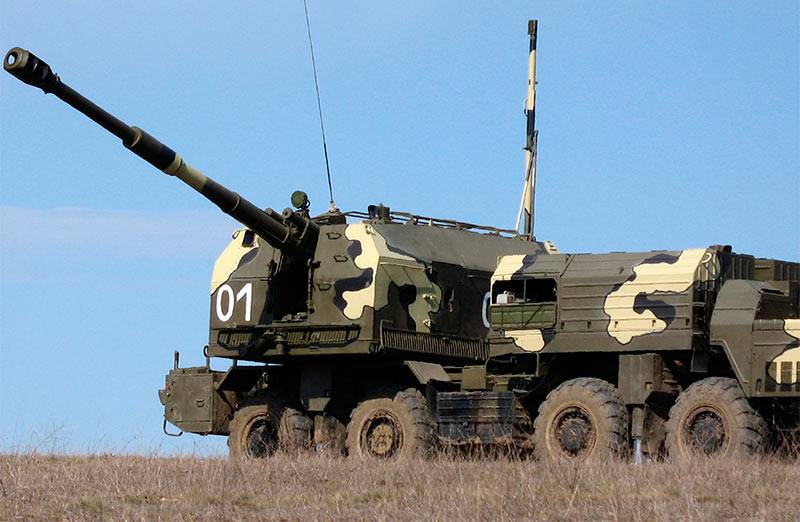
High potential
In the past, during tests, the A-222 Bereg BAC confirmed the design characteristics and showed the ability to solve all expected tasks. Such results were obtained through the use of a number of important ideas and technical solutions of one kind or another, optimal for the intended scope of application.
First of all, you should pay attention to the approach to ensuring mobility. The complex was built on a wheeled chassis, which improved the transfer speed and simplified operation without significant losses in maneuverability - this parameter remained at an acceptable level. As a result, Bereg has high mobility and is capable of operating along the entire Black Sea coast.
The A-222 uses a modified 130 mm ship gun. The AK-130 and its “Bereg” variant show a fairly high firing range and use a large-caliber and high-power projectile. At the same time, logistics are optimized. Ships and shore units do not need to be supplied with different ammunition.
Of particular interest in the Shore project are control systems. The complex received its own radar and optical means, with the help of which it detects and tracks targets, fires and makes adjustments. Data processing is performed automatically. Firing is also carried out without human intervention, with the exception of general control over the operation of systems and the supply of ammunition.
A control system of this kind makes it possible to identify and hit all intended targets - surface objects of various sizes in open spaces and skerries, as well as ground targets in different landscapes. Of particular interest is the complex’s ability to attack and hit small moving targets, which present a certain complexity.
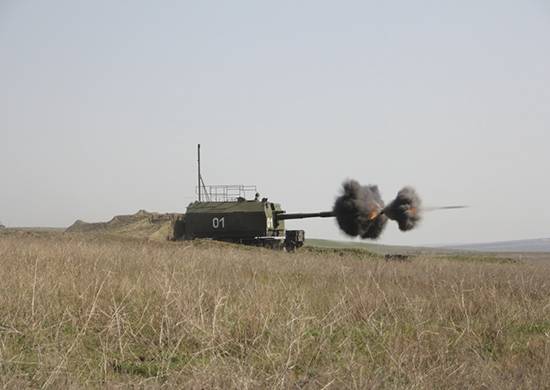
The effective use of the complex in different compositions is envisaged. It is possible to operate both all means and its individual self-propelled guns. However, in the latter case, the absence of a central post negatively affects the speed, accuracy and ability to adjust fire.
The 130-mm Berega gun has a firing range of up to 23 km. In this regard, it is inferior to modern domestic artillery systems, not to mention missile systems. Nevertheless, the achieved fire characteristics are fully consistent with the intended combat missions. Landing craft and other enemy targets operating near the coast are considered typical targets for the A-222. The existing projectile and a range of up to 20-23 km are quite sufficient to destroy them. A few hits can cause serious damage to larger targets.
Optimal variant
The A-222 “Bereg” coastal artillery complex occupies a special place in the armament system of the coastal forces of the Russian Navy. Unlike other artillery systems, it was created specifically for coastal defense, taking into account its needs and operating characteristics. Due to this, high efficiency of application is achieved in solving all intended problems.
Despite all its advantages, the Bereg UAV was produced in a limited series and entered service with only a few units. The total number of such equipment in service is small, and only one fleet has it. However, it is precisely in the zone of responsibility of the Black Sea Fleet that this complex can show the best results, both independently and together with other coastal defense systems. And in the current situation, such opportunities in the region, at a minimum, will not be superfluous.
Information